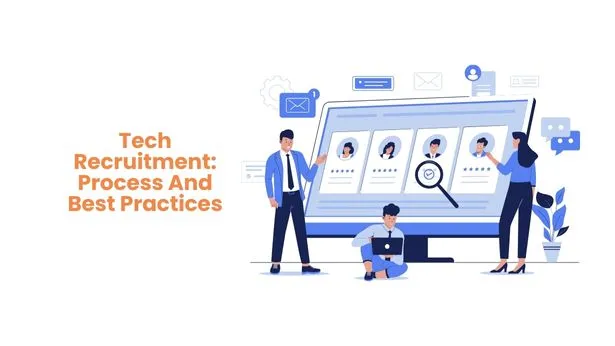How to Run a Technical Recruitment Process
When organizations ask a question, ‘How do we run a technical recruitment process?’, the first step is to define ‘technical recruitment process’. The technical recruitment process is a defined process that focuses on identifying, attracting, assessing, and hiring people for technical roles. The recruitment process places a major focus on assessing the technical capabilities of candidates; there is also an emphasis on evaluating candidates’ problem-solving abilities and cultural fit, as well as their ability to work in an increasingly fast-changing tech environment.
This blog is all about a detailed description of the technical hiring process, explaining technical recruitment best practices and outlining the steps to recruit technical candidates to develop the best, most innovative tech team possible.
What Is a Technical Recruitment Process?

Technical recruitment is the defined sequence of actions a business takes to hire employees for technical jobs. The technical recruitment process usually uses technical qualification tests, coding exercises, and a holistic assessment of the candidate’s portfolio, past experiences.
At a minimum, effective technical recruitment allows you to not only fill an empty chair, but to fill the chair with people who can execute on your product goals and are culturally aligned to your company. Through the adoption of best practices in the technical recruitment process, you will essentially eliminate unnecessary hiring risks and maximize the chances of long-term success with your team.
What Are The Steps For Hiring Tech Talent Effectively?
Here are some of the steps that help in hiring tech talent:
1. Identify the Role and Clarify Business Goals: An effective technical recruiting process begins with a clear understanding of the role you need to fill. This means primarily identifying the required programming languages, frameworks, tools, and experience level. You want to partner with your engineering team to outline not only the technical requirements but also the key accountabilities and measures of success.
2. Choose Candidates Wisely: If you want to hire tech talent, you must source your candidates wisely. You can grow your candidate pool with professional networks. A list of potential sources includes:
- LinkedIn, Stack Overflow, GitHub, and other professional networks.
- Tech Meetups, Conferences, and Hackathons.
- Partnerships with Coding Bootcamps, Colleges, or Universities.
- Employee Referral Program.
3. Review Resumes and Portfolios Carefully: Once candidates have applied, the next step in the technical recruitment best practices is an in-depth review of resumes and portfolios. Pay special attention to candidates’ real work, coding projects, and open-source contributions to projects. You can automate this process using these tools to help filter applicants, but you should also review the resumes and portfolios manually to ensure you are considering quality work and relevance to the role.
4. Measure Skills with Technical Assessments and Coding Tests: One of the most important steps in the guide to the technical hiring process is confirming candidates’ skills with technical assessments and coding tests. You can cover a variety of assessment formats, such as:
- Online coding tests that resemble the job you expect the hire to do.
- Real-world take-home assessments.
- Live coding.
The combination of assessments will provide a deeper understanding of a candidate’s technical problem-solving capability, coding style, and process, which all contribute to how you will successfully attract the top technical candidates to apply.
5. Analyze soft skills and cultural fit: Technical skills are important, but not enough. Assess the candidate’s ability to communicate, work as part of a team, adapt to change, and mesh with your organization’s culture. General qualifiers or behavioral interviews, as well as situational questions, provide significant context in all of these areas to evaluate candidates holistically.
6. Bring Other Stakeholders to the Interview: Having other folks involved – HR, technical leads, potential peers assists in developing a well-rounded perspective of the candidate. Including this diversity of input in the evaluation process can help eliminate unconscious bias and ensure that the candidate is a good fit technically and culturally.
7. Deliver Feedback On Time and Meaningfully: A best practice for technical recruitment is to maintain clear and transparent communication with candidates. After each stage of the interview process, deliver timely feedback (positive or negative) to keep candidates engaged as well as to respect their time.
8. Assemble a Competitive Offer and Ensure Seamless Onboarding: Once you have identified the right candidate, you will want to make a competitive offer based on market insights and the candidate’s expectations. It is important to remember that benefits, work-life balance, career advancement, etc., can be just as important when compared to base salary.
Also Read: How AI is Redefining Recruiting
Technical Recruitment Practices Every Company Should Follow
Technical recruitment is a strategic practice that requires diligence when hiring, as the right hire can impact innovation, project success, and ultimately, business growth. In our experience, we recommend that companies implement the technical recruiting best practices every company should follow to create a clear job description, use skills assessments, and ensure a great candidate experience.
1. Clearly Define the Role: A detailed job description, laying out technical skills, responsibilities, and growth potential, will help you attract the appropriate candidates.
2. Use Technology & Assessments: Not every assessment is created equally. Use coding challenges, technical tests, and AI-powered platforms to evaluate candidates fairly and effectively.
3. Proactively Sourcing: Instead of waiting for applicants to apply to you, you should be searching in talent pools, developer communities, and networking sites for potential candidates.
4. Culture Fit and Skills: Technical skills are very important, but if you must choose between culture fit and technical skills, culture fit is much more important for long-term success.
5. Streamlined Process: Don’t leave candidates in the dark, don’t take too long to make decisions, be transparent, and give as much feedback as you can to improve their experience.
Final Call on Effective Technical Recruitment Process
Learning how to manage a technical recruitment process is critical for organizations competing for the best technical talent. By implementing clearly defined steps to effectively hire technical talent, following technical recruitment best practices, and using a complete guide to the technical hiring process, you will be able to confidently recruit the best technical candidates to elevate your business.
FAQs on Technical Recruitment Process
Q1. What is a technical hiring process?
A structured, consistent way to hire candidates for technical positions that emphasizes measuring technical skills and assessing the cultural fit.
Q2. How do I implement the technical hiring process effectively?
Define the role iteratively, be strategic with your sourcing, assess the candidate properly, identify soft skills aligned to performance, and provide timely feedback.
Q3. Why are technical skills assessments important?
They validate candidates’ skills and verify their ability to solve problems relative to the job description.
Q4. How do I attract passive tech candidates?
Networking, referrals, attending tech events, and engaging in tech communities.
Q5. Which are the soft skills that would be important in a technical hiring process?
Communication, teamwork, adaptability, and cultural fit.
Q6. Who should be involved in the interviewing committee?
HR lead, technical lead, and possible teammates to encourage a fair assessment of candidates.
Q7. How quickly should candidates receive post-interview feedback?
Within a few days, to keep them engaged and respect their time.
Q8. What makes a job offer competitive when recruiting tech candidates?
Salary (in line with the prevailing market rates), benefits, flexibility, and promotion of learning and development.
Related Article: Top 7 Skills Tech Recruitment Agencies Prioritize






